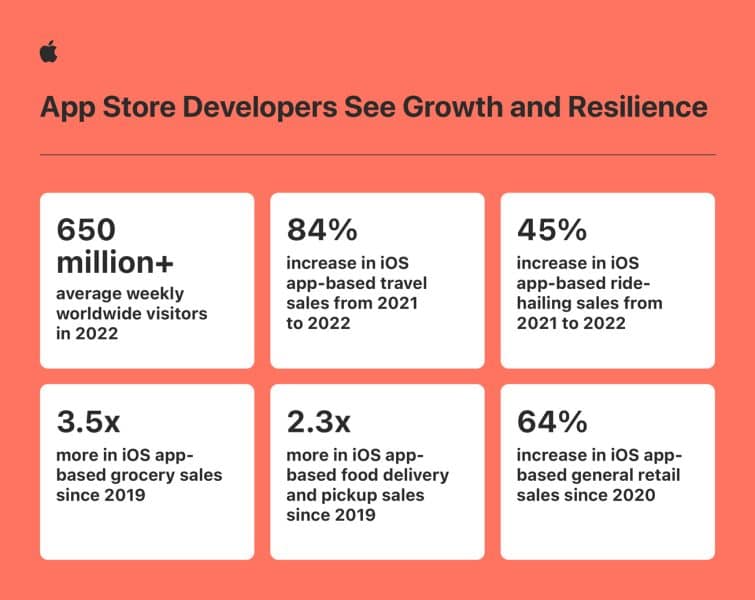
The Apple App Store had a record-breaking year in 2022, raking in $1.1 trillion for developers according to information provided by the company today. Developers saw their billings and sales grow by 29% from 2021 to 2022 thanks to the popularity of the firm’s mobile marketplace.
More than 90% of these total billings and sales went directly to developers with no commission taken by Apple. Meanwhile, small developers experienced the most growth, increasing their revenue by 71% between 2020 and 2022. Read the full report here.
Several app categories flourished in 2022 as demand rebounded following the pandemic. Travel app sales grew by 84% as restrictions eased while ride-hailing app sales increased by 45%. Food and grocery delivery apps also saw massive growth, with food delivery sales more than doubling since 2019.
Advertising in apps was also a huge revenue driver, making up $109 billion of that $1.1 trillion. Social media and retail apps in particular saw strong ad growth while gaming apps continue to be among the most popular and financially successful on the App Store.
App Store Creates Thousands of Jobs Globally and Supports Developers
The Apple (AAPL) App Store ecosystem now supports an estimated 4.8 million jobs across the U.S. and Europe. Apple developers have earned more than $320 billion since the App Store’s launch in 2008. In addition, over 370 billion apps have been downloaded from the App Store in that time.
This growth shows the vitality and innovation of the App Store ecosystem, according to economists from the Analysis Group who conducted a study on the subject. They highlighted the many opportunities that the App Store provides to developers of all sizes around the world.

The App Store has invested heavily in tools and resources to support developers and their businesses. Forty SDKs, 250,000 APIs, and programs like the Apple Developer Academy help developers build successful apps and businesses.
The mobile store’s security and privacy protections are also crucial to its success. Apple rejected 1.7 million apps in 2022 for not meeting its standards while blocking $2 billion in fraudulent transactions. Recent innovations like App Tracking Transparency have also empowered users with more control over their data.
Governments are Forcing Apple to Give Developers More Freedom
The release of these stats comes at a point when the company headed by Tim Cook and founded by Steve Jobs is being scrutinized for its monopolistic practices along with Alphabet (GOOG).
The commissions charged by Apple for in-app purchases have been considered too high, standing at 30% of the amount billed by developers in most cases. Moreover, developers were not able to use a billing system apart from Apple Pay to process customers’ payments.
Regulators in multiple corners of the world have been acting to regulate the company’s dominance and unfair business practices. In June 2020, the European Commission opened an investigation against the company concerning “the mandatory use of Apple’s own proprietary in-app purchase system and restrictions on the ability of developers to inform iPhone and iPad users of alternative cheaper purchasing possibilities outside of apps”.
When it comes to gaming apps, Apple has not conceded to regulatory pressures or legal proceedings such as the lawsuit by Epic Games after its flagship game Fortnite was banned from the App Store for bypassing Apple’s billing system. However, the firm has reduced its cut for some non-gaming apps and has even waived the fee entirely for some developers in particular.
Another controversial aspect of the App Store is that it is the only mobile marketplace that can be installed on an Apple device, with the iPhone arguably being one of the top-selling mobile phones in the world.
It is, however, quite obvious why Apple is so protective of its App Store ecosystem. During the first quarter of 2023, the company’s Services revenues, which include income from the App Store, reached a quarterly record at $20.8 billion. This segment accounted for nearly a quarter of the firm’s overall top-line figure.
Other Related Articles: